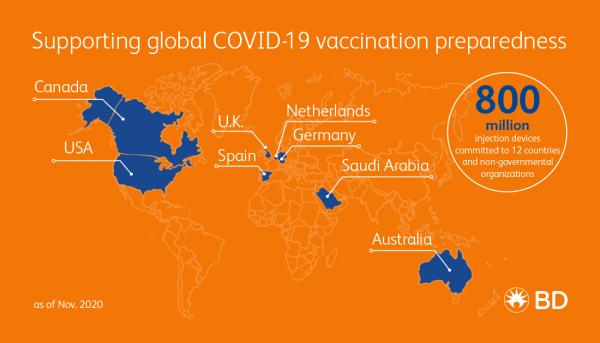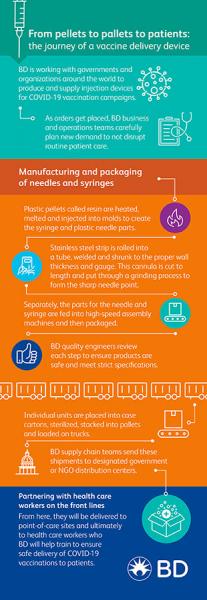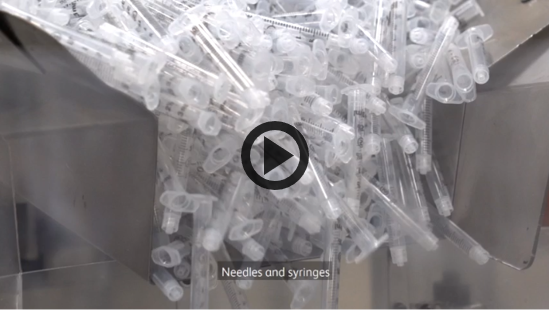As each day passes, researchers get closer to finding a vaccine that can help stop the COVID-19 pandemic. At the same time, countries around the world are preparing vaccination delivery campaigns to make sure that when the time comes, they have the right injection devices and supplies stockpiled to administer the vaccine to their populations.
BD has committed more than 800 million needles and syringes to date in support of COVID-19 vaccination campaigns globally – with discussions underway to provide millions more devices.
But what happens next? How do these orders get into the hands of the health care workers who will be using them to deliver a vaccine? Getting an order placed is just the start of the process for a med-tech company like BD.
Let’s follow the journey with the U.S. as an example.
The U.S. government has placed orders for 286 million needles and syringes from BD, with 256 million to be supplied by January 2021. These devices will help deliver a safe, effective COVID-19 vaccine to millions of Americans as soon as one is available.
Planning demand to protect patient care
While BD produces billions of needles and syringes for the U.S. every year – only a fraction of these devices are used to deliver vaccines. The company’s manufacturing operations are setup to produce enough devices to meet existing demand to support routine health care delivery. In the case of new orders from the U.S. government, BD business and operations teams must carefully plan so they don’t disrupt ongoing patient care needs for equally important public health programs like the annual flu vaccination and childhood immunizations.
Manufacturing and packaging of needles and syringes
BD manufacturing teams then need to make the devices. While it may seem simple, these are highly calibrated, highly sophisticated medication delivery devices.
Plastic pellets called resin are heated, melted and injected into molds to create the plastic parts that make up a syringe like the barrel and plunger rod. The plastic parts of a needle – the hub and shield – are made the same way. The needle is created using stainless steel strip that is rolled into a tube and welded. A metalworking process called drawing is then used to shrink the tube until it gets to the proper wall thickness and gauge (the outer diameter measurement), and then cut to length. These blunt metal tubes called cannula then go through a grinding process to form the sharpened point, used to penetrate the skin when delivering the vaccine.
Separately, the components for the needle (cannula, hub and shield) and for the syringe (barrel, plunger rod, stopper) are fed into high-speed assembly machines and the final products enter packaging machines. The individual units are placed into case cartons that are sterilized on site, stacked onto pallets and loaded on trucks. Along the way, BD quality engineers review each step of the process to ensure products are safe and meet stringent quality inspections and specifications.
Shipping finished products to U.S. government distributors
BD supply chain teams will then ship the devices to distribution centers for the U.S. government’s chosen COVID-19 vaccine distributor partner, McKesson2. That’s more than 6,400 pallets of shipments by January 2021! From here, they will be delivered to point-of-care sites across the country based on the government’s COVID-19 distribution strategy.
Partnering with health care workers on the front lines
BD’s work doesn’t stop at device delivery. As a strategic partner with decades of experience in vaccine delivery – from polio and meningitis to seasonal flu and smallpox – BD will continue to be by the side of health care workers on the front lines to ensure safe administration of COVID-19 vaccinations.
Supplying the world with devices to fight COVID-19
Since the start of the pandemic, BD teams have been working around the clock, discussing needs with governments across the globe and running needle and syringe production lines 24/7. By maximizing these efforts, BD is striving to supply the world with a billion injection devices by the end of next year to fight COVID-19.
This is no small task. To produce a billion devices in the next 12 months equates to nearly 2,000 devices every minute on top of BD’s normal volumes to fully support routine health care needs. But with more than 120 years of history in manufacturing needles and syringes, an incredibly dedicated team of associates around the world and shipments underway, BD is committed to doing everything we can to prioritize patient care during these difficult times, while meeting requests for vaccination needs of the communities we serve. Learn more about BD’s vaccine preparedness efforts.
We’re in it together. Delivering COVID-19 vaccinations will take the cooperation of the entire marketplace, government agencies, multilateral organizations, vaccine manufacturers and distribution partners working collectively to stop the pandemic.
1 Office of the Assistant Secretary for Public Affairs. 1 September 2020. “Fact Sheet: Explaining Operation Warp Speed” HHS.gov.
2 HHS Press Office. 14 August 2020. “Trump Administration Collaborates with McKesson for COVID-19 Vaccine Distribution” HHS.gov.
Subscribe to receive BD blog alerts


